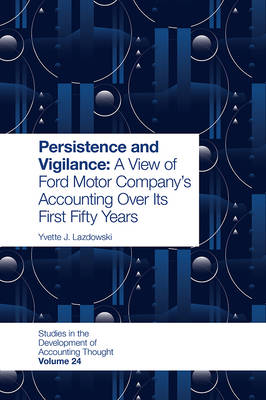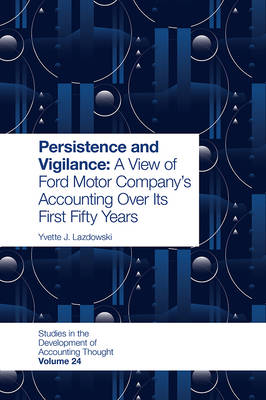
- Afhalen na 1 uur in een winkel met voorraad
- Gratis thuislevering in België vanaf € 30
- Ruim aanbod met 7 miljoen producten
- Afhalen na 1 uur in een winkel met voorraad
- Gratis thuislevering in België vanaf € 30
- Ruim aanbod met 7 miljoen producten
Zoeken
Persistence and Vigilance
A View of Ford Motor Company's Accounting Over Its First Fifty Years
Yvette J Lazdowski
€ 180,45
+ 360 punten
Omschrijving
Persistence and Vigilance: A View of Ford Motor Company's Accounting Over Its First Fifty Years is an exploration of the financial leadership that guided the company through periods of phenomenal growth amidst the economic and political upheaval of the early 20th century.
Since its inception in 1903, the Ford Motor Company has implemented traditional accounting methods, as well as innovative financial reporting and business policies, to navigate industry competition, two world wars, and labor issues such as the famous $5 day. While much has been written on the presumption of Henry Ford's indifference to the financial details of operating the company that bore his name, there remains much to be said for the talented individuals working behind the scenes to spearhead the day-to-day financial and operational policies of the company. This includes initial co-founder James Couzens, super salesman and accountant Norval Hawkins, loyal Frank Klingensmith, and turn-around specialist Ernest Breech, among others. It was through their skill, persistence, and acumen that accounting policies and procedures evolved within the Ford Motor Company alongside the welcomed support of Edsel Ford, who was widely respected in his vision for strong financial oversight and organizational structure.
From archival information found in the Benson Ford Research Center, this book describes the accounting and financial reporting methods utilized by the company through its years of growth, wartime production, economic downturns, and eventual restructuring under the presidency of Henry Ford II. It is essential reading for anyone interested in the history of the Ford Motor Company, as well as those curious about the application of accounting within the fast-growing automotive industry in the early to mid-1900s.
Since its inception in 1903, the Ford Motor Company has implemented traditional accounting methods, as well as innovative financial reporting and business policies, to navigate industry competition, two world wars, and labor issues such as the famous $5 day. While much has been written on the presumption of Henry Ford's indifference to the financial details of operating the company that bore his name, there remains much to be said for the talented individuals working behind the scenes to spearhead the day-to-day financial and operational policies of the company. This includes initial co-founder James Couzens, super salesman and accountant Norval Hawkins, loyal Frank Klingensmith, and turn-around specialist Ernest Breech, among others. It was through their skill, persistence, and acumen that accounting policies and procedures evolved within the Ford Motor Company alongside the welcomed support of Edsel Ford, who was widely respected in his vision for strong financial oversight and organizational structure.
From archival information found in the Benson Ford Research Center, this book describes the accounting and financial reporting methods utilized by the company through its years of growth, wartime production, economic downturns, and eventual restructuring under the presidency of Henry Ford II. It is essential reading for anyone interested in the history of the Ford Motor Company, as well as those curious about the application of accounting within the fast-growing automotive industry in the early to mid-1900s.
Specificaties
Betrokkenen
- Auteur(s):
- Uitgeverij:
Inhoud
- Aantal bladzijden:
- 216
- Taal:
- Engels
- Reeks:
- Reeksnummer:
- nr. 24
Eigenschappen
- Productcode (EAN):
- 9781838679989
- Verschijningsdatum:
- 2/11/2020
- Uitvoering:
- Hardcover
- Formaat:
- Genaaid
- Afmetingen:
- 157 mm x 231 mm
- Gewicht:
- 340 g

Alleen bij Standaard Boekhandel
+ 360 punten op je klantenkaart van Standaard Boekhandel
Beoordelingen
We publiceren alleen reviews die voldoen aan de voorwaarden voor reviews. Bekijk onze voorwaarden voor reviews.








